
The best way to start a conversation in South Africa may be to ask someone how they braii (South African outdoor grilling, but don’t call it barbecue). Everyone has an opinion on how to position the wood and/or charcoal and the grate, what type(s) of firestarters to use (liquid petroleum, briquettes, etc.), how long to cook things for, and, most importantly, how long to let the wood burn down to charcoal before cooking. The standard operation at the campground I stayed at was for someone to decide they wanted to braii. Then that person would get the fire going in the metal drum or pit. That usually involved a bunch of fresh wood.. They’d let it burn hot for about an hour or so, until it was mostly reduced to charcoal and was mostly consistent heat without smoke. Then they’d put whatever they wanted to cook on the grill. Low and slow is the idea.
But then, once they were done, and that charcoal was still going to be hot for a couple hours at least, at least a handful of other people would ask if they could stick their food on the fire. It’s the sneaky way of braii-ing – just wait until the first person is done and then the fire is perfect. It was cheaper (because you didn’t buy the wood), faster (because you didn’t waste an hour monitoring the coals) and made for better fire (you knew the wood had burned down enough, so the heat would be consistent and not burn your food), but you end up waiting until about 10pm to eat because you’d have to wait for the first person to be done and then you’d still have to wait an hour for your food to cook.
The first time we tried to braii was at our campground in Rocklands (here’s the photo of the braii set up from my Instagram). It was 7pm, way too late to start the multi-hour process, so we did the North American thing and stuck our food on too soon (in the interest of eating before midnight). The flames licked the meat and the fat dropped down and then the flames flared up and the meat charred/burned. It was still delicious, but it wasn’t braii.
But the second time, we started the fire at 3pm (it was a rest day from climbing, so we had time). We used a frew bricks of firestarter (after watching some youtube videos) and fresh wood. We waited 1.5 hours as the wood burned down to charcoal. (You can also just buy charcoal and this is all much faster.)
Then we watched some more YouTube videos about how to push the charcoal to one side and how to position the meat on the grate above. Then we wrapped our sweet potatoes in foil and put them directly into the charcoal. Then we put our chicken and peppers on top. We covered the braii and sat on our back patio near the fire for an hour as the sun set on a cloud-free July day in Emgwenya.
It was heaven. It was the only time that trip that I got the sweet potatoes consistently to the point where their sugars caramelized and they cooked the whole way through without burning. And it was the only time our chicken didn’t burn, but smoked just enough to give a chew to the crust with a tender inside. We ate it all with a sweet-and-spicy South African peri-peri sauce.
Local fruit and vegetables in South Africa in winter
Besides braii, the other food highlights of the five-week trip for me were the fresh local produce (even the winter salad tomatoes had actual flavour) and the quality of meat. The first day when we stopped at a grocery store, we saw local papayas, persimmons, pears, big and small oranges, mandarins, clementines, purple yams, cucumbers and bunches of bananas.
What we didn’t see was just as interesting. There were no local berries (only expensive imported ones) or lettuces besides iceberg. So I bought some endive for a salad with sautéed peppers, cucumbers and tomatoes. I splurged on mushrooms once (which was more expensive than the fancy mesclun mix I also avoided), but the mushrooms were just mild mushrooms.
The chicken breasts were a treat, though. They came bone-in and skin-on and tasted like chicken, as opposed to factory-farmed North American chicken breast that often tastes like nothing. We seared them outside in a pan in the cold air and deglazed with chopped tomatoes.
I’m glad I stocked up on the small persimmons I spotted that first day, because we never saw them again, the season being at its end. We did find local Medjool dates, though. And I ate my weight in papaya, favouring the seeded Zimbabwe ones with their funkier, sweeter flavour compared to the seedless South African ones. The prices were about 1/3 of what I’d pay in Canada, so I tried small ones, medium and large (we only get the large Mexican ones and sometimes smaller Hawaiian ones in Canada).
We stuffed our extra oranges into the communal fridge at Basecamp Rocklands, which had more space than our mini fridge by our unheated caravan. We were worried about animals if we left fruit outside, but nothing touched the papayas. Nights were so cold that we shouldn’t have worried about the oranges going bad outside either.
We’d take hot showers in the outdoor washroom area, then dry off and throw our clothes on as fast as possible (longjohns, parkas, thick socks) to walk back through the brush-lined sandy paths to our caravan. The people staying in tents must have had their down sleeping bags because it got down to maybe 5-10 degrees Celcius some nights. The first thing we’d do in the morning would be to light the gas burner for hot water to warm up.
Once the sun hit, though, we’d be plenty warm.
Tea Tasting in Clanwilliam
I liked the tea tasting we did at a farm stall in Clanwilliam called Velskoendraai on a rest day. I’d hoped to go to a rooibos plantation (Rocklands is in the heart of the geographical indication for rooibos tea), but it never worked out. Instead, after the tasting, I took my notes and I dragged my partner from specialty shop to grocery after grocery looking for looseleaf green, unfermented rooibos (my favourite from the tasting, though the Cancerbush was the strongest, more interesting flavour). We got to pick 7 types of rooibos (or rooibos-related) teas to sample in their own tea pots, one by one. They were labeled and described by the server. This was clearly not their first tea party, in the best way. The green, unfermented had the most tea-like flavour, with stronger tannins and a little bitterness, as opposed to red fermented rooibos with its natural sweetness.

Looking for quality wine in Cederberg, land of citrus
We also tried to go to the local big wine producer, Cederberg, which had a Blanc de Blanc sparkling wine that I thought would be funt o try at their tasting room. But the rain and the long ride on a dirt road off the highway scared us off with our cheap rental car. So instead we tracked up and down Highway 7 and tried to find a wine shop that carried the blanc de blanc. We drove through Citrusdel (Valley of Citrus) then back for two hours because things were closed or not promising (e.g. a shop would have only one type of wine or junk commercial options). Cederberg wines are pretty easy to find through South Africa, but not the Blanc de Blanc. We ended up at a place called N7 on Wine (a shop directly off the N7 highway). It looked like a warehouse or factory from the outside, with big trucks stopping there for deliveries or pickups, but inside was all local products, from preserved meat to pickled vegetables, marmalades, honeys and wines… including the blanc de blanc!
I asked the woman there about natural wines and she said there were a couple, so I bought a pinotage she recommended. It was not awesome. She hadn’t mentioned that the area the winery was in was not a good region for pinotage. It was like a not-so-great beaujolais nouveau. Junky juice. Fine for cooking, though, so used it for braising lamb and chicken.
We probably should have gone with a red blend instead.
But the blanc de blanc was amazing. At 300 Rand versus the 80 Rand of the pilotage ($20 instead of $6), it wasn’t cheap, but compared to Champagne (and it does hold its own for quality), it was a steal.

We saved the bottle until we got to Cape Town a week later. Then we drank it with a local fish, roasted sweet potatoes (so much easier to get right than braii-ed ones) and a big salad. We liked it even better than the giant skillet of fish, shrimp, mussels and clams we ate at the marina earlier that day (that’s where we bought the fish because fish in Cape Town in grocery stores is not a thing unless it’s breaded and frozen in finger form).

The closest town to Rockland is Clanwilliam, which was…stark. It seems pretty safe, but people sit outside the grocery store asking for food. The town definitely has less good areas (you feel it when you get off the paved roads and hit dirt ones), so we avoided driving through those areas. But the grocery store had all the basics we needed, and plenty of fruits and vegetables and meats. Vegetarian options are slim beyond beans and lentils, but at least there are those.
Lots of workers in rubber boots ride seatbeltless on the backs of trucks, likely hitching rides to and from work at the dam. We figured having a car is pretty expensive here. Gas prices were the same as in Canada, whereas everything from food to accommodations was about 1/3 the price of home. So carpooling and hitching makes a lot of sense for locals. It’d be too risky for most foreigners.
We felt pretty safe in Cape Town in the touristy areas, but it was worth taking a cab to Cafe Ganesh, a university student hangout (so we were told by our campground owner and friends) with big servings of local food at good prices. We agree. We couldn’t walk there in the evening, but we got dropped off and picked up right at the door by the taxis we ordered on our app. this is what we ate:

It’s hard to see, but it’s a massive plate of sweet tomato-based lamb knuckle stew with creamy beans and corn called samp, a traditional xhosa dish. The lamb was fall-off-the-bone tender and samp was filling and super savoury and deep. I bought a bag in the grocery store and ended up with pretty bland and gelatinous porridge instead of this creamy masterpiece (but I still liked it). After a day of climbing, it hit the spot with a bottle of (sweet, but not too sweet) Savanna cider.
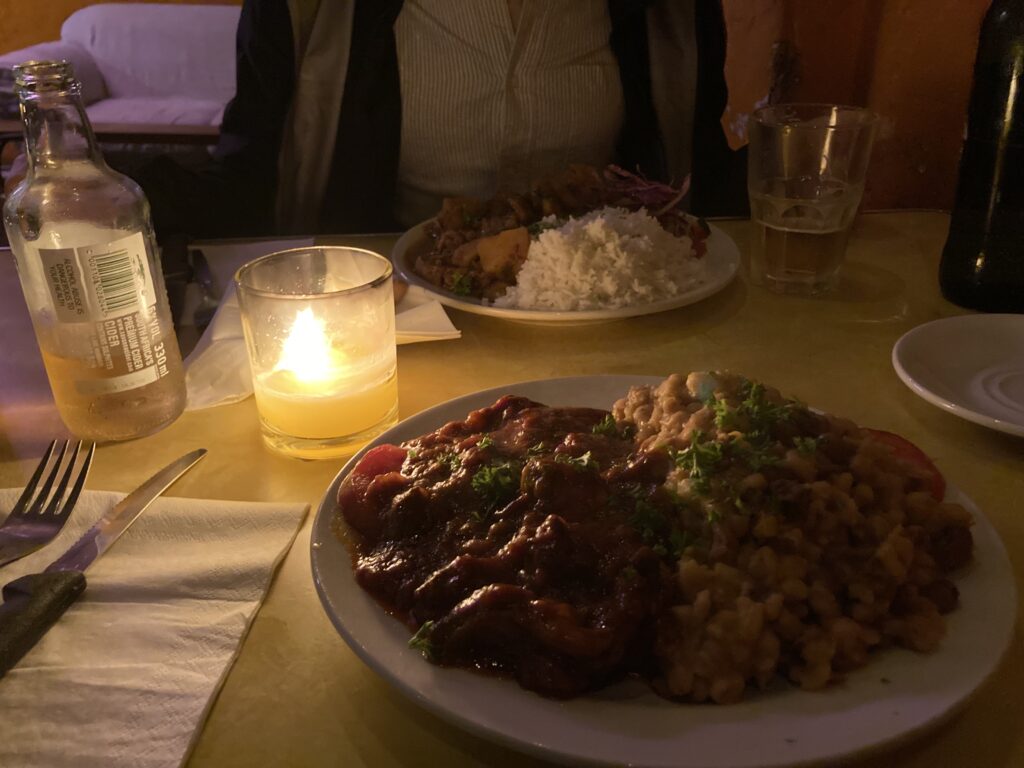
The heaping plate on the other side of the table is the chicken curry with basmati rice and chakalaka, a sweet-and-sour vegetable dish. I appreciated that the restaurant culd tell me what was in each dish, so I could make sure it was gluten-free. I also appreciated that they said they didn’t use seasoning powders like Maggi, which I react to.
Our other Cape Town favourites included the highly recommended Jason’s, a bakery/cafe in the Green Point neighbourhood. The donut of the day was a big hit, but any of the pastries or cakes in the counter display when you walk in look amazing, especially the savoury pies and sweet danishes. I liked my red espresso with almond milk, a caffeine-free rooibos-based espresso with my choice of milk.
And I can’t forget Harbour House at the V&A Waterfront. I was pretty surprised to find that there aren’t a lot of seafood restaurants in Cape Town, or seafood shops, even. I was looking for local and sustainable, but I could barely find anything beyond frozen breaded fish sticks at the grocery store. One exception was Harbour House, where we waited a brief 10 minutes in the busy lunch-time weekend line on a rainy Saturday in July and splurged on the seafood selection, a giant platter of Langoustines, prawns, mussels, linefish, fried and grilled calamari tubes and fried hake goujons (my partner got the breaded things on the side).

For our linefish we chose the local kingklip, and bought some fresh kingklip from the seafood counter at the back for dinner later that night. It’s tender and flaky, but with more body and butteriness than cod. Maybe somewhere between cod and halibut, less firm than mahi-mahi. We got to choose our sides (or bases) with it, and we went with a paella-style rice and super soft sweet potato pieces. We wished we’d gotten more sweet potato. You can also get salad, but that seems sad when the amount of rice is massive and filling. This is a pricy dish, but in Canadian dollars, for the quality and variety, it was kind of a joke.
There was also a sushi menu, which more people seemed to be ordering from than the other fish options, but we avoided it, because besides the fresh tuna (which I can get in North America), most things were the same pre-frozen, pre-sliced items I’d see at so-so places in Montreal.
And as we were arrogantly chuckling aobut the price of our giant platter of perfectly cooked seafood (the kingklip and langoustines were our favourite, because we can’t get those in Canada, but we liked the calamari tubes a lot too), our next door neighbours (the seating options include long communal tables like ours) asked how the prices compared to Canada. Turns out the man was a fish wholesaler. Just who I wanted to chat with about fish and prices! He was there with his wife, enjoying some local wine like everyone else (because it’s cheaper than bottled water! My partner and I decided to split a half carafe of a local white for the same reason. It wasn’t fancy, but it was a decent pairing with the seafood). He told me about kingklip and how there’s lots of seafood in South Africa but t’s very expensive and local stuff can be hard to get in Cape Town at least. That’s what I remember anyway.
Wine Tasting at Babylonstoren
I could write a whole post just about the wine tasting we did at Babylonstoren, a massive working farm and boutique hotel and restaurant (think kilometres of citrus trees, grape vines and free-range cows, chickens and other animals. Medicinal plants, herbs, olives, berries, bees. And a very impressive cellar with amphora, stainless steel and wood barrels for their full line of wines. The tasting is well-organized and comes with a food pairing bite for each glass, which are ample. It’s a romantic downstairs space, clearly with a lot of financing, but also with incredible local staff.


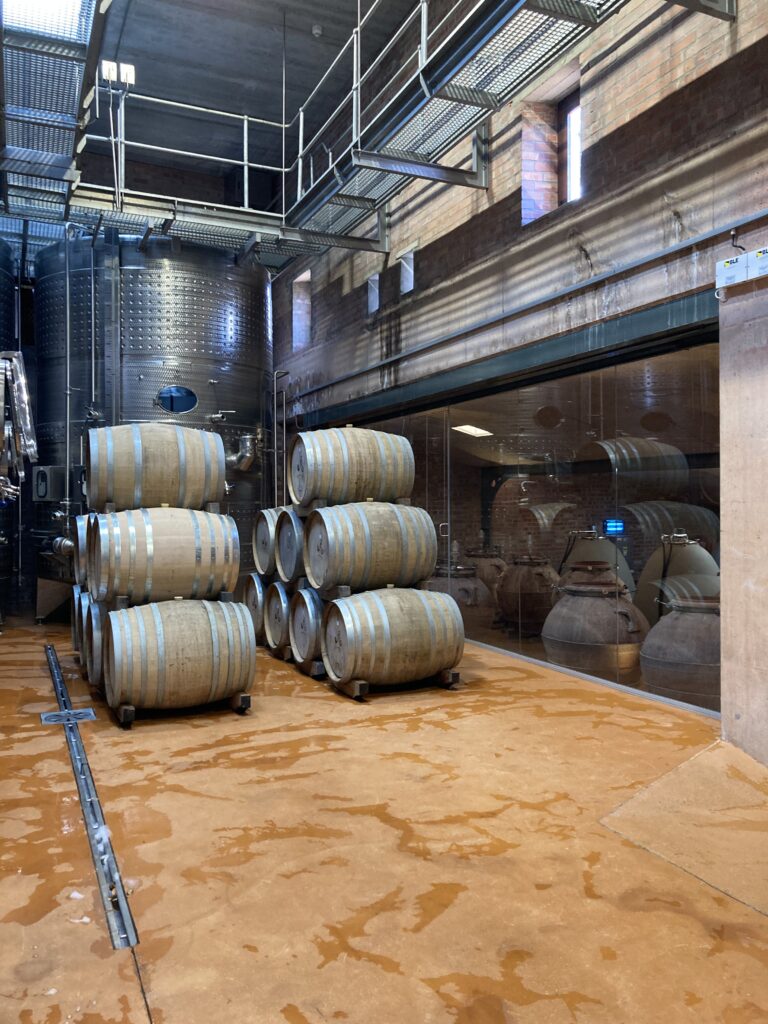



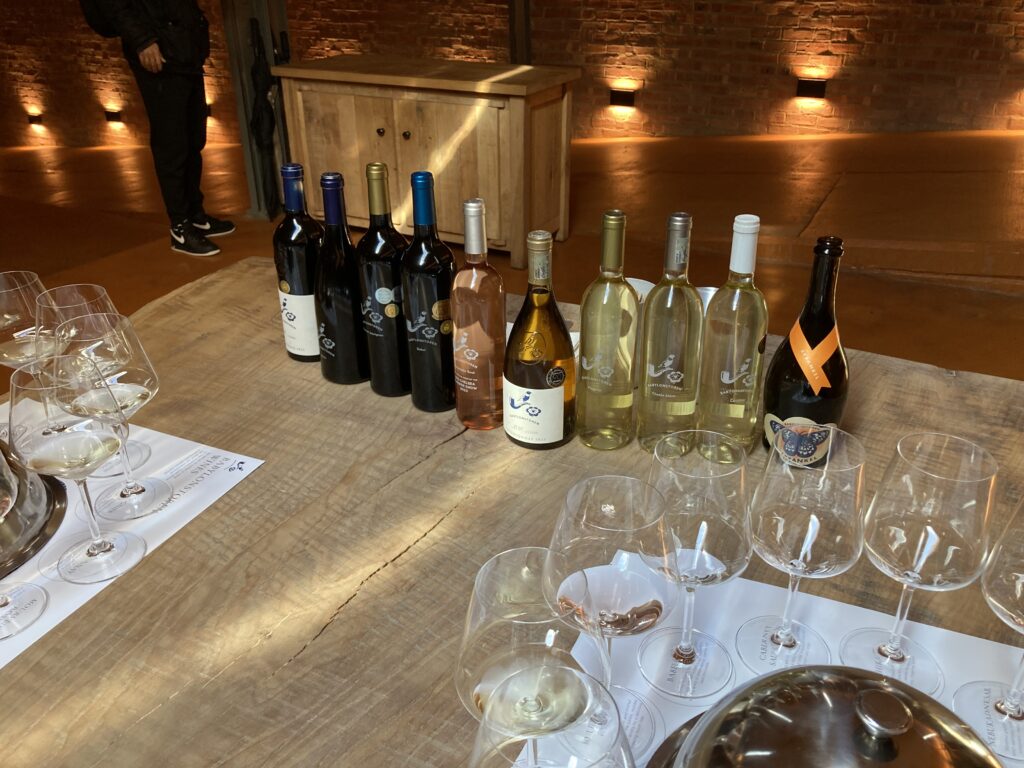


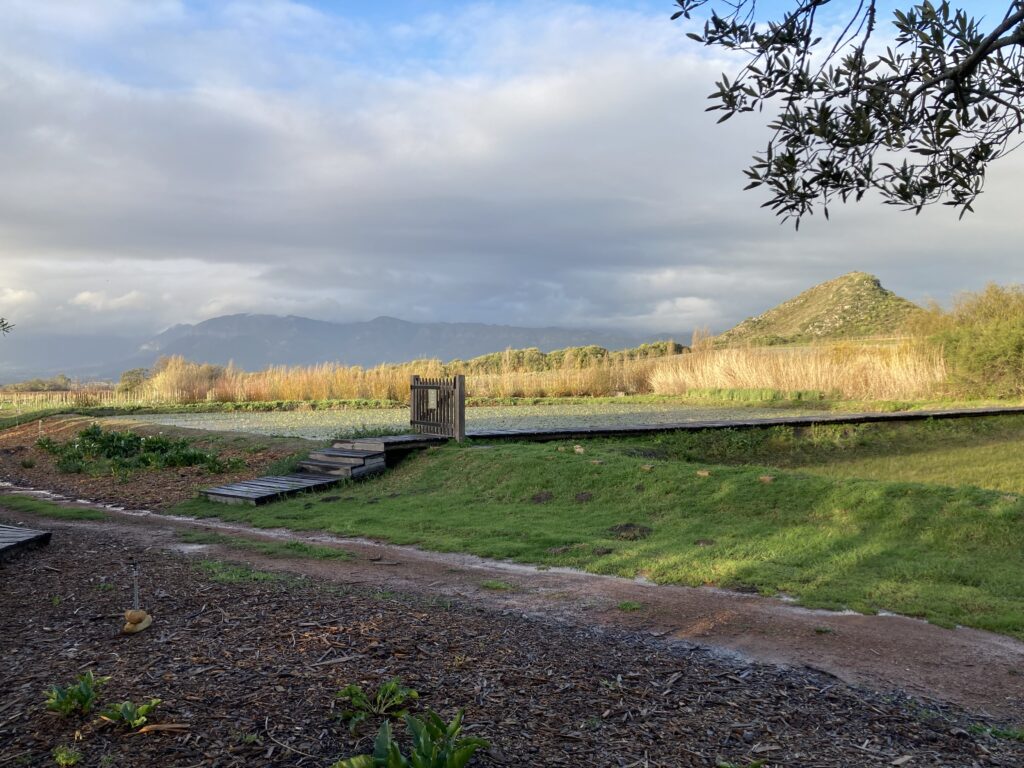
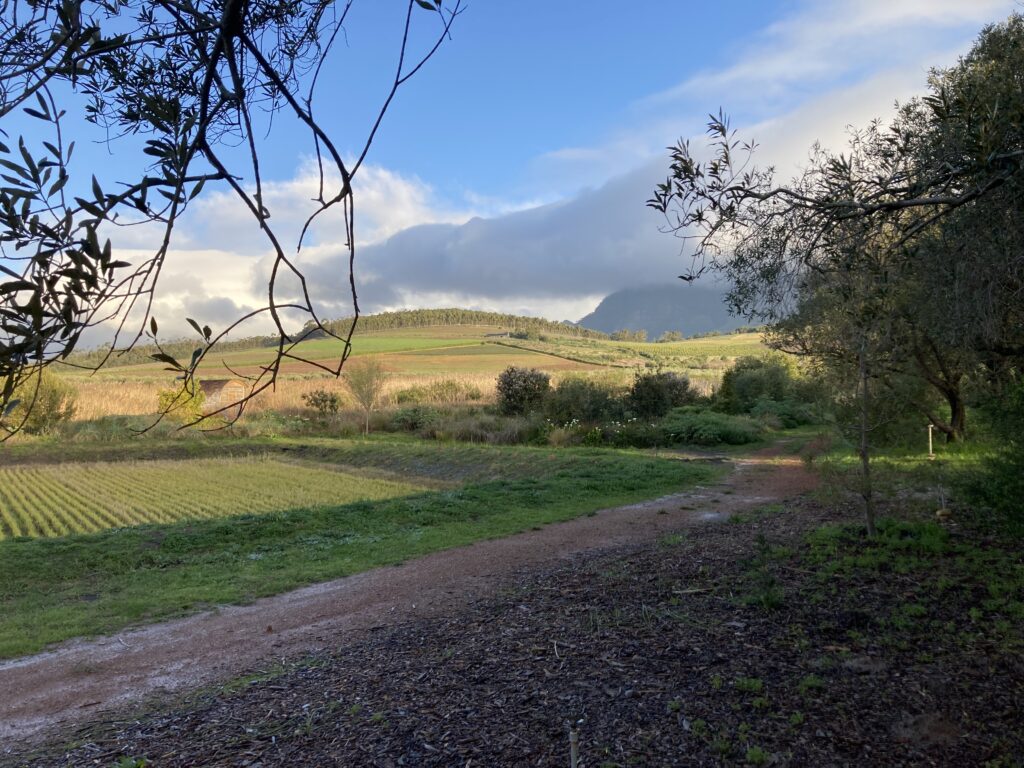
I was planning to spit most of the wine, because I was driving (very common for tastings), but the group we were with was some people celebrating anniversaries and special occasions, so it felt weird to spit with the peer pressure. I ended up giving half my tastings to my partner, but even then it was a lot for me. So we spent a couple hours afterwards walking around the gorgeous property in the crisp air, checking out the friendly cows and the citrus orchards. My favourite was a red blend called the Babel blend (the less pricey one, made with Shiraz pinotage, cabernet sauvignon, merlot, petit merlot, grenache noir, and barbera). I might have missed one? The blend changes every year, I think.
Heading northest of Johannesburg
We felt less safe up north in Emgwenya, where we went to climb routes at Waterval Boven. We wondered why the area never became an international destination. It was empty all week, with Johannesburg climbers showing up on weekends. When we got to our accommodations, we were the only people there in the big building. We figured maybe the area used to be a bigger destination for climbing and it had declined, but apparently not. It just never grew.
The question stuck with us. Why did Rocklands get so popular and Turkey and Spain and Greece, but not here? There’s six months of great weather a year, it’s not much harder to get to than Turkey if you’re coming from overseas, and there’s a lot of super high-quality climbing thanks to massive bolting efforts over the last maybe 40 or so years (sorry, I read the history in the original guidebook but my memory isn’t the best). There are lots of crags, but we really only fell in love with the Tranquilitas area. The others were a little less frequented, it seemed, and were either trickier to get to or felt isolated. We wanted to climb trad at the Junkyard on a rest day, because it had a couple of highly rated lines, but it turned out the Junkyard is now an actual junkyard where people throw their garbage. Tranquilitas is stunning, once you drive up past the other junkyard on a very bouldery, sunken dirt road for 20 minutes.
Our guess on why this hasn’t developed into a huge climbing destination, where people go to Rocklands and then tack on a couple weeks at Waterval Boven like we did, is because there are only a few awe-inspiring crags, the kind that make your jaw drop. It just doesn’t look as impressive as the Red, maybe? Or maybe it’s just the distance or the safety? It wasn’t unsafe, but we had to be more aware of what we were carrying on us and where we went. We couldn’t really walk around the town freely on a rest day. Wwe needed to be accompanied to a parking area and needed to have our host make sure our car would be able to park there safely that day. There are fewer accommodations. And some of the less frequented climbing areas have routes that are dirty or dusty or runout, with some old bolts and rusted chains.
But for all those reasons, it was way more of an adventure.
We met people who came back for months every year. And people who also felt that the top climbs stacked up to those other international destinations. We spent two-and-a-half weeks here and didn’t get bored, even sticking mostly to Tranquilitas and trying just a few other places.
Wasn’t this a post about food?
I’ll end with a shout-out to Pete the butcher in Emgwenya, who sold us delicious lamb. Let’s call him the spice pusher, because every purchase came with a little bag of his secret spice blend.
And I still think about those persimmons.
Leave a Reply